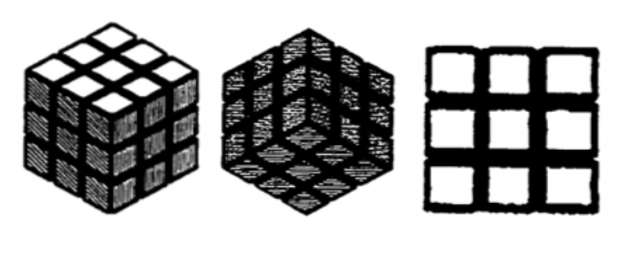After a turbulent procedure before the EUIPO and then before the Community court, the Court of the European Union annulled on 24 October the European Union trademark of Rubik’s Brand for the famous Rubik’s Cube (1). The latter’s competitor, Simba Toys GmbH, had requested the cancellation of the said three-dimensional mark as early as 2006, on the ground that the sign in question consists exclusively of the shape necessary to obtain a technical result. Indeed, the technical result sought is to rotate the vertical and horizontal bands of the cube, in order to obtain three consecutive squares of the same color.

Despite the product’s rotational capabilities, the EUIPO had considered that the graphic representation of the brand, consisting of three views of a 3 x 3 x 3 x 3 cube, in which each square is separated from the neighboring squares by a black outline, did not suggest any particular function. This analysis in line with the Cancellation Division’s first decision was confirmed by the TEU, which considered that the essential characteristics of the Rubik’s Cube did not fulfill a technical function of the product in question. Since the product’s rotation capacity results from internal and invisible mechanisms, the Court concluded that this technical dimension cannot be considered as one of the essential characteristics of the three-dimensional mark. However, the Court of Justice overturned this analysis on the grounds that the essential characteristics of a shape must be assessed in the light of the technical function of the product concerned. The TEU should therefore have defined the technical function of the product in its assessment of the functionality of the essential characteristics of the sign.
The case was therefore referred back to the EUIPO Board of Appeal, which this time confirmed the Court’s analysis and annulled the contested trade mark accordingly. A new appeal was brought by Rubik’s Brand before the TEU.
Is it possible to reconcile the need to guarantee the original identity of the product specific to trademark law with technical innovation under patent law? These rationales seem to be mutually exclusive: the arbitrariness of the three-dimensional shape of the trademark will be affected by the functionality of the product, thus determining its presentation. This will necessarily lead to a standardization of the shape of the product due to its technical specificities, which will result in an unjustified monopoly of the company in question on the market.This monopoly would be particularly damaging to competition, as it would be subject to eternal ten-year renewals. Indeed, this situation could turn into an abuse of a dominant position, insofar as this illegitimate monopoly could allow the company holding the intellectual property rights to hinder effective competition by multiplying independent behavior towards its competitors, its customers and, ultimately, consumers.
Illegitimate monopoly since it contradicts the logic underlying the granting of an intellectual property right: rewarding an investment with a temporary monopoly, the duration and extent of this reward depending on the nature and scope of the innovation or creation. Indeed, any modern economic regime implies sanctions, in both senses of the word, reward and punishment. In 1962, Raymond Aron pointed out this need and explained how to encourage production incentives by encouraging proportionality between the effort and the contractor’s performance (2).
In this case, it’s a question of rewarding an investment, of course. But should the technical or commercial dimension of the product in question be given priority?
Patent law seems appropriate since we are obviously dealing with a technical creation. In addition, it is worth recalling the existence of a Hungarian patent filed by Erno Rubik in 1975 on his famous Cube. This patent has expired, without an international patent application having been filed. Consequently, Rubik’s Cube no longer enjoys protection as such, and will no longer be able to benefit from such protection in the future (the condition of novelty can no longer, of course, be met).
It is interesting to note that the operators of the Rubik’s Cube have also tried to claim, without success, copyright on Erno Rubik’s famous creation. In 2012, the Paris First Instance Court ruled that copyright is also not enforceable against third parties because the choice to associate a cubic shape with 6 very common colors does not in any way demonstrate the imprint of the author’s personality and cannot give Rubik’s cube an originality making it protectable under copyright’ (3).
In the context of this dispute before the Paris First Instance Court, the validity of a French trademark and two Community trademarks relating to the Rubik’s Cube was also called into question.
However, the Paris First Instance Court had concluded that three-dimensional trademarks were distinctive. In particular, it was noted that the shape of the latter was not imposed by the nature or function of the product, insofar as other shapes would have achieved the same technical result. We remain skeptical about such an argument, since the Court of Justice had indeed enshrined the abandonment of the theory of the multiplicity of forms in trademark law ten years earlier in its famous Philips judgment.
The Paris First Instance Court also considered that the trademarks were widely used by the operating company, so that the sign was widely known to the general public, thus reinforcing the distinctive character of the said trademarks. The First Instance Court therefore seemed to recognize the distinctiveness of the disputed marks by reasoning in terms of notoriety and the acquisition of distinctiveness through use, an analysis which already seems more convincing but unfortunately not developed by the French court in this decision.
In short, the Rubik’s Cube case shows a misuse of the objectives of intellectual property rights, since companies have a clear tendency to engage in a race to acquire such rights in order to accumulate them on the same subject. This is sometimes to the detriment of maintaining effective competition.
By its latest decision of 24 October, the First Instance Court decided this question of accumulation of rights by holding that the sign in question cannot fulfill its essential function of guaranteeing the identity of origin, because of the functional nature of the product in question.
Rubik’s Brand based its defense before the Court on the fact that the essential characteristics of the product had not been properly determined, and on the fact that other forms would have ensured the same technical result, arguing that the functionalities of the Rubik’s Cube had not dictated its form. The sign in question would therefore be such as to enable the consumer to identify the commercial origin of the product. In particular, the applicant argued that the grid structure was above all an ornamental and fanciful element, which therefore played an important role in the form at issue as an indicator of origin.
The Tribunal rejects these two arguments of Rubik’s Brand.
First, the TEU notes that the essential characteristics of the contested mark are limited to the overall shape of the cube, on the one hand, and to the black lines and small squares on each side of the cube, on the other. This is specified that these essential characteristics represent the constituent elements of the shape itself, i.e. the elements which are themselves of a three-dimensional nature or which define the contours of the three-dimensional shape, unlike any other characteristic of the contested mark.However, the essential characteristic consisting of intersecting black lines on each side of the cube is necessary to obtain the desired technical result, since it is a physical separation between the different small cubes. This separation allows the rotation of the different rows of cubes thanks to the mechanism located in the center of the cube. Without this physical separation, the cube in its overall form would therefore only be a solid block, with no individual elements that could be moved independently.
Secondly, the TEU rejects the applicant’s argument that there are alternative geometric shapes that can achieve the same technical result. Indeed, since the Philips case law of 2002, this is irrelevant that there are alternative forms that make it possible to obtain the same technical result, in the context of examining the functionality of the essential characteristics of a form (4).
Consequently, since the two essential characteristics of the contested trade mark are necessary to obtain the technical result sought by the specific product concerned, the trade mark in question falls within the scope of the absolute ground for the invalidation of functional forms.
This is interesting to note the resolutely teleological dimension of the Tribunal in its analysis. Indeed, the Union’s court recalls that, in the European system of intellectual property rights, technical solutions are only likely to be subject to protection of limited duration. In this way, the latter can be freely used later by all economic operators. In its 2010 Lego judgment, the Court of Justice already specified that where the shape of a product merely incorporates the technical solution developed by the manufacturer of that product and patented at its request, protection of that shape as a trademark after the expiry of the patent would considerably and perpetually reduce the possibility for other companies to use that technical solution (5). In this context, the registration of a shape as a trade mark is likely to enable the proprietor of that trade mark to prohibit other undertakings not only from using the same shape, but also from using similar shapes, which could render unusable a significant number of alternative shapes for the proprietor’s competitors.
With this decision, the TEU rejects the use of intellectual property rights. Underlying this is also the objectives pursued by the European Union, namely to limit obstacles to the free movement of goods within the internal market by granting circumscribed and justified monopolies to companies. As John Stuart Mill noted in his book On Liberty in the 19th century, trade is about social acts. Thus, anyone engaged in trade engages in an activity that affects the interests of others, and of society in general; therefore, trade falls within the jurisdiction of society and is guided by imperative of the general interest.
In this respect, it should be recalled that, while Article 36 TFEU incorporates the protection of industrial and commercial property as a ground for restricting the free movement of goods, the case law of the ECJ has always sought to affirm that this exception to the freedoms of movement is strictly interpreted.
1) TEU, 24 October 2019, Rubik’s Brand Ltd/EUIPO and Simba Toys GmbH and Co, T-601/1
2) Raymond Aron, “Dix-huit leçons sur la société industrielle”, Editions Gallimard, Collection Folio Essais, p. 207
3) TGI Paris, July 6, 2012, 3rd ch., 3rd section, n° 11/00091
4) ECJ, 18 June 2002, Philips, C-299/99, paragraphs 81 to 83; ECJ, 14 September 2010, Lego Juris/OHMI, C-48/09 P, paragraphs 53 and 58
5) Judgment cited above, ECJ, 14 September 2010, Lego Juris v OHIM, C-48/09 P, paragraph 46
Clara Grudler
Lawyer and student at La Sorbonn
Translation credit : Eva Gauthier
